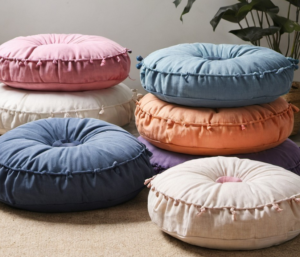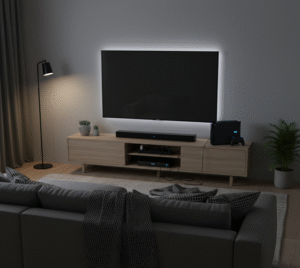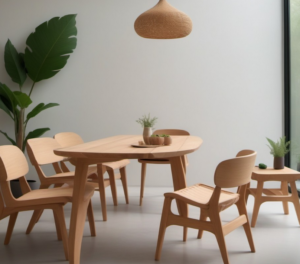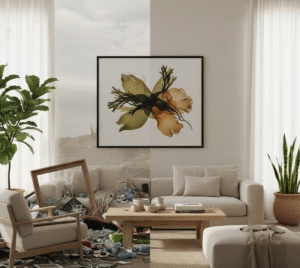Why Your Walls Are Quietly Making Your Home Look Dated
You walk in and something feels… off. You’ve changed the paint, swapped cushions, and even moved the furniture around. But the room still feels hollow. Empty.
Most times, it’s not the color. It’s the walls themselves. They’re too plain, too flat, too echoey.
Cork accent panels fix that. They add texture and warmth in ways you don’t expect until you see them in place. The moment light hits that surface, it softens the whole space.

What Are Cork Accent Panels, Really? (And Why Designers Can’t Shut Up About Them)
Cork accent panels are made from the bark of cork oak trees, pressed into tiles or sheets. You stick them to your walls like panels or thick wallpaper.
They’re natural, warm to the touch, and a little sound-absorbent. It’s not hype, there’s a reason designers and homeowners are quietly swapping Sustainable Paint Options: Healthier, Eco-Friendly Alternatives for Your Homepaint for cork.
You get texture, pattern, and this grounded feeling that no synthetic wall finish can match. A good overview of how cork changes room acoustics can be found in this cork wall guide.

The Subtle Psychology Behind Cork: Why It Just Feels Right
Humans like imperfection. Smooth, glossy surfaces tire the eye. Rough, natural ones calm it down. That’s part of why cork works so well, it feels alive.
When you walk into a room with cork panels, the space feels quieter, like it’s holding you rather than bouncing your voice back.
You can sense it even before you notice it. That’s texture doing its job.
The Fear You Don’t Talk About: Is Your Home Missing Character?
A lot of modern interiors look smart but cold. Perfect lines, neutral tones, all the right pieces, but no soul.
It’s an uncomfortable thought, right? You look around and wonder: is my home just… fine?
Cork brings back that bit of warmth and humanity. It’s not decoration for the sake of it. It’s presence. You don’t even have to cover a full wall, one stretch of cork can shift how a whole room feels.

The Benefits You Actually Feel
You’ll notice the difference almost immediately. The echo softens. The wall doesn’t feel cold. The light picks up a new warmth.
And there’s function in there too: cork panels help with acoustics, temperature stability, and even air quality. You can read a solid breakdown of these effects in this acoustic and thermal benefits overview.
It’s one of those upgrades you don’t need to explain to guests, they just walk in and say, “this feels nice.”
How to Use Cork Accent Panels Without Going Overboard
Restraint matters. Covering every wall makes your space feel heavy.
Try a single wall behind your bed for warmth. Or your home office backdrop for a softer sound on calls. In a dining area, cork adds quiet intimacy.
Think of it as texture, not statement. The best cork walls are the ones that look like they’ve always belonged there.

Common Mistakes People Make (And How to Dodge Them)
Biggest mistake? Treating cork like wallpaper. It’s not.
People often buy thin, cheap panels and expect perfect soundproofing. Or they place cork in dark corners where it disappears.
Get a few samples first. Test them in your light. Invest in panels thick enough to do their job. And please, don’t go for the lowest price. It’ll crumble, peel, and ruin the look you were going for.
DIY or Call a Pro? Depends on You
If you’ve got a steady hand, a roller, and patience, you can install cork panels yourself. There’s a clear step-by-step installation guide here.
That said, if you want perfectly aligned seams, or you’re covering a ceiling or tricky corner, hire someone. Installers know how to get the best acoustic results with small air gaps and mounting tricks.
DIY is fun, but it’s also easy to make a mess with adhesive if you rush it.

The Sustainability Bonus You Might Not Expect
Cork is harvested without cutting down trees. The bark regrows every decade or so. That’s rare.
You get a renewable material, low VOC levels, and zero plastic smell. If sustainability matters to you, cork is a genuinely responsible choice. You can dig into its regenerative process in this cork life cycle overview.
Before You Buy: What to Check
Don’t just grab the first nice-looking sample online.
Check thickness, finish, and whether it’s pre-sealed. Hold samples up to your wall and see how light plays off them.
Ask about sourcing if you care about origin, some brands use recycled cork, some don’t.
When a texture feels right, you’ll know.

The Quiet Upgrade Your Space Deserves
There’s a difference between a decorated room and one that feels right.
Cork doesn’t shout. It doesn’t sparkle. It just makes everything else in the space make more sense.
Once you live with it, bare walls start to feel… naked.
Quick FAQ
Q: Does cork really help with sound?
Yes, though it’s for softening echoes, not full soundproofing. You can read more about it here.
Q: How long will it last?
Years. It’s flexible and durable as long as you install it right.
Q: Can I paint over cork?
You can, but it kills the texture, and that’s half the point. Leave it natural if you can.





